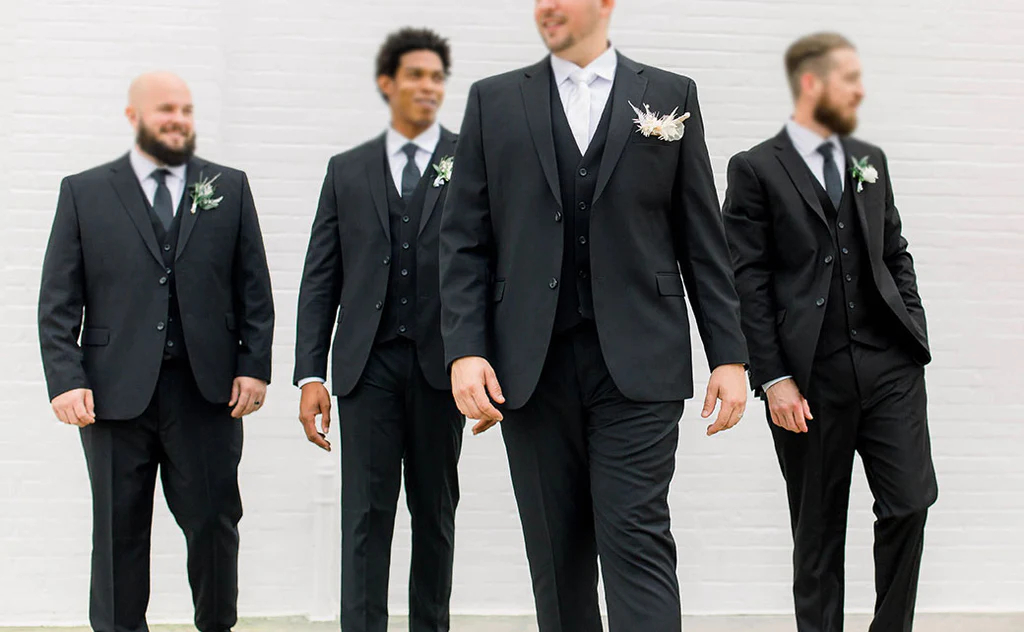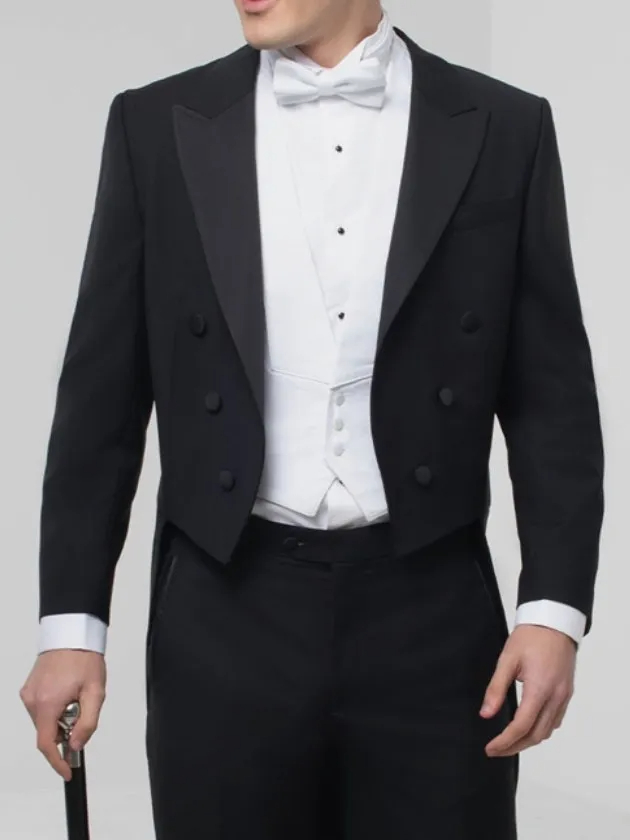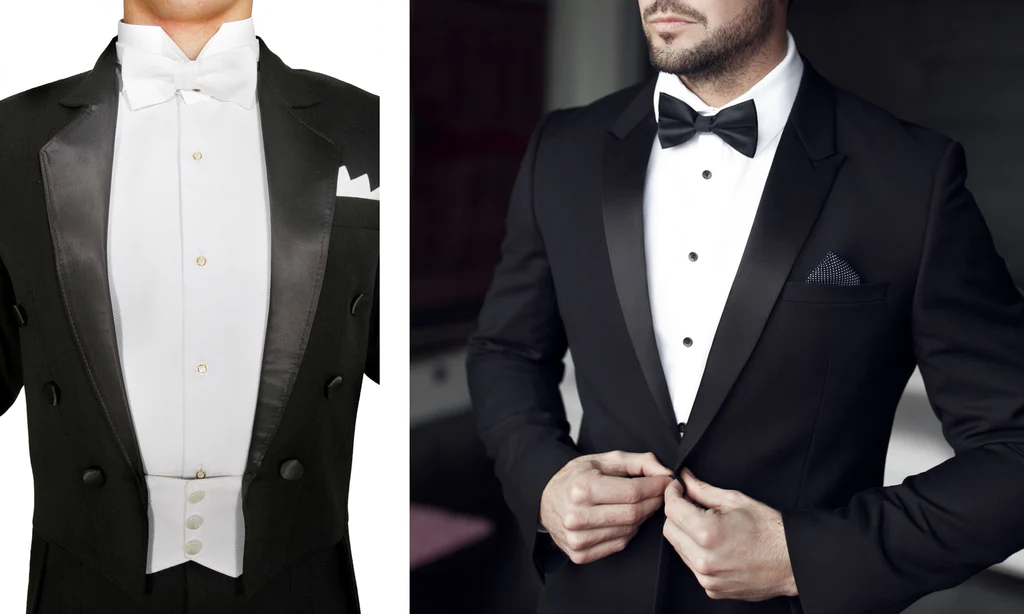Introduction
Black tie vs white tie are two of the most formal dress codes for special occasions, each with its own specific rules and traditions. Understanding the differences between Black Tie and White Tie can help you navigate formal events with style and confidence.
Black Tie:
Black Tie is a dress code commonly seen at evening events such as galas, formal dinners, and weddings. The key elements of a Black Tie dress code for men typically include a black tuxedo jacket, matching trousers with a satin stripe down the leg, a white dress shirt, a black bow tie, and black dress shoes. Accessories such as cufflinks, a pocket square, and a formal watch can add a touch of sophistication to the ensemble.
For women, Black Tie attire often consists of elegant floor-length gowns or cocktail dresses in dark or neutral colors. Accessories like statement jewelry, evening bags, and heels complement the formal look. While Black Tie allows for some flexibility in terms of dress styles, it is essential to maintain a sense of elegance and refinement when interpreting this dress code.
White Tie:
White Tie is the most formal dress code, reserved for prestigious events such as state dinners, royal receptions, and high-level ceremonies. For men, White Tie attire includes a black tailcoat with tails, matching trousers with a satin stripe, a white pique wingtip-collared shirt, a white bow tie, black patent leather shoes, and accessories like cufflinks and a white pocket square. The overall look is characterized by its ultra-formal and traditional aesthetic.
Women’s White Tie attire typically consists of full-length ball gowns in rich fabrics and colors, often embellished with intricate details such as beading or embroidery. Elbow-length gloves, elegant jewelry, and sophisticated updos are common additions to complete the formal ensemble. The focus is on timeless elegance and regal sophistication when dressing in White Tie attire.
Key Differences:
The main distinction between black tie vs white tie lies in their formality and level of traditionalism. Black Tie is considered formal but allows for more modern interpretations and variations in attire, making it a versatile choice for a range of events. In contrast, White Tie adheres to strict sartorial guidelines and is reserved for the most elite and ceremonial occasions, demanding the highest level of elegance and adherence to tradition.

Black Tie:
Originating in the 19th century, Black Tie emerged as a less formal alternative to the ultra-formal White Tie dress code. It gained popularity as a standard for evening events requiring a touch of sophistication and refinement. The black tuxedo jacket, a cornerstone of Black Tie attire, symbolizes understated elegance and timeless style. Paired with matching trousers featuring a satin stripe, the ensemble exudes a sense of luxury and class.
The white dress shirt worn with a black bow tie in a Black Tie outfit creates a striking contrast, adding a touch of formality to the ensemble. Accessories such as cufflinks, a pocket square, and dress shoes complete the look, emphasizing attention to detail and sartorial finesse. While Black Tie allows for some individual expression and personal style, adherence to certain key elements ensures a cohesive and polished appearance suitable for a range of formal occasions.
For women, Black Tie presents an opportunity to showcase elegance and sophistication through carefully curated attire. Floor-length gowns or chic cocktail dresses in dark hues or neutral tones are popular choices, allowing for versatility while maintaining a sense of formality. Accessories play a crucial role in elevating the ensemble, with statement jewelry, evening bags, and heels adding a touch of glamour and refinement to the overall look.
White Tie:
White Tie represents the pinnacle of formal dressing, characterized by its strict adherence to tradition and formality. Originating in the 19th century as the preferred attire for royal courts and exclusive events, White Tie remains synonymous with prestige and regal sophistication. The black tailcoat, a defining feature of White Tie attire, signifies opulence and grandeur, while the white pique wingtip-collared shirt and white bow tie exude an aura of refinement and aristocracy.
Men’s White Tie attire emphasizes impeccable tailoring and attention to detail, with accessories such as cufflinks, a white pocket square, and patent leather shoes completing the ensemble with finesse. The traditional nature of White Tie attire demands adherence to specific guidelines, reflecting a commitment to upholding centuries-old customs and formalities associated with elite social gatherings.

Cultural Significance:
Black Tie and White Tie dress codes are steeped in tradition and cultural symbolism, serving as a visual representation of elegance, refinement, and social status. Originating in the elite circles of European aristocracy and high society, these dress codes were closely associated with exclusive events, royal gatherings, and diplomatic ceremonies. Over time, they became emblematic of grandeur and sophistication, embodying a set of sartorial guidelines that transcended fashion trends and stood as a testament to classic style and timeless elegance.
The adoption of Black Tie and White Tie dress codes by prestigious institutions, diplomatic circles, and high-profile events further solidified their status as symbols of formal excellence and cultural significance. These dress codes continue to be revered for their ability to convey an air of respectability, grace, and decorum, making them an integral part of formal occasions across the globe.
Enduring Appeal:
Despite the evolution of fashion and changes in sartorial preferences, Black Tie and White Tie dress codes have maintained their allure and relevance in the modern era. Their enduring appeal lies in their ability to evoke a sense of nostalgia for a bygone era while remaining steadfast in their commitment to upholding timeless traditions.
For individuals attending formal events, embracing Black Tie or White Tie attire offers an opportunity to step into a world of refined elegance and ceremonial splendor, allowing them to pay homage to the rich heritage of formal dressing. The meticulous attention to detail, the emphasis on quality craftsmanship, and the celebration of classic silhouettes contribute to the enduring appeal of these dress codes, resonating with those who appreciate the artistry and sophistication inherent in formal attire.

Conclusion
When deciding between black tie vs white tie for an event, it is essential to consider the dress code specified on the invitation and the nature of the occasion. By understanding the nuances of each dress code and selecting appropriate attire that reflects the formality and tone of the event, you can ensure that you make a polished and sophisticated impression while honoring the traditions associated with formal dressing. 
